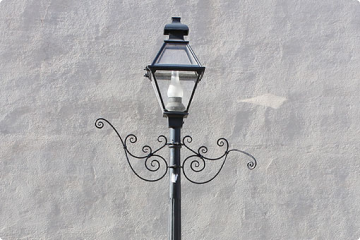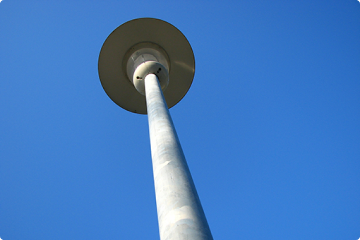Stability inspection
The stability inspection process by Roch Services GmbH
A mobile test device is at the heart of the process which can be used at practically any site. A hydraulic, finely controlled cylinder stresses the mast system with a timed load at a height of approx. 2 m with continuously increasing force. It generates a continuously increasing bending torque in the mast, which simulates the natural wind load to which a mast is exposed. The stability test comprises a compression and a tension process and is carried out in two different axes which are offset by 90 degrees. This makes it possible to check the areas at risk. The introduced force and the generated deflection of the mast in connection with the time component are simultaneously measured, recorded and evaluated in force-displacement or force-time diagrams.
An initial assessment is already carried out on site. This is made possible by specially developed software that constantly monitors the testing process and thus offers a maximum of informative value, reliability and reproducibility. After completing the on-site inspection, all characteristic curves are reassessed in a second functional analysis independently by two inspectors. The collected data are reflected in the results of the inspection logs for the customers.
The testing method is
- safe
- reliable
- quick and flexible
- legally usable
- certified
- traceable
- reproducible
- with company accreditation
- patented throughout Europe
In connection with the test procedure you will receive information on
- Mast geometry
- Material
- Mast height/wall thickness
- Attachment parts
- Coatings
- Cuffs
- Type of mast flap
- Light type
- Location characteristics
- Floor covering (type of clamping)
- Identification data
- Photograph of the mast
- Visual abnormalities
- GPS coordinates (optional)
- Economic efficiency calculation (optional)
Testing objects
The importance of stability testing
Economic efficiency/sustainability
Municipalities and operators of installations with vertically anchored systems have a duty to ensure public safety. This means that they are responsible and must ensure that there is no danger to third parties from the vertically anchored systems. The regular, indistinguishable replacement of masts (e.g. by year of construction) causes unnecessarily high costs and severely burdens any available budget. The principle of economic efficiency is disregarded when large numbers of intact masts have to be replaced in order to eliminate potential risks. Such an approach should be avoided, especially in times of sustainable management. There is one uncomplicated and economical way out of this situation, in which almost every management, every company or every sports facility operator has found itself: the testing procedure of Roch Services!
Accreditation / certification
Roch Services GmbH is a testing laboratory accredited according to DIN EN ISO/IEC 17025 and certified according to DIN EN ISO 9001. The German Accreditation Body (DAkkS) issued the accreditation for the following scope of application:
‘Non-destructive testing (load testing) of the stability of masts and similar standing and anchored systems’.
The management system and the technical competence of Roch Services GmbH are regularly monitored by the Deutsche Akkreditierungsstelle GmbH (DAkkS) as an independent body. Further details on the significance of accreditation can be found on the website of Deutsche Akkreditierungsstelle GmbH.
Quality
The Roch stability test was developed in cooperation with experts in metallurgy, materials science and statics. State-approved experts have reviewed and confirmed the results several times.
We continuously carry out intensive research work and investigations in the areas of the causes and course of damage to mast systems. The results flow into our work. And we have our performance regularly audited by independent institutions and experts.
Our well-trained staff is the precondition for high quality standards. For this reason, our employees are constantly being trained (further) in our own competence centre for street lighting. There they receive the necessary qualifications and the awareness for the responsibility towards our service.
Studies
We carried out the first nationwide study on the stability of mast systems. Our 2000 Infrastructure Project Street Lighting Study enables us to make statistical statements on the stability of mast systems in Germany. These are, for example, the possible forms of damage or influencing factors.
The conclusion of our study is that 3.3% of the poles examined in Germany are not stable. This means that, statistically speaking, 825,000 masts represent a daily hazard to humans. This figure illustrates the need for meaningful stability tests.
Legal validity/ legal situation
No traffic participant in the public area, whether motorist, cyclist, pedestrian, athlete, or visitor to a sports facility considers the safety of the masts that illuminate the event. And they don't have to, because it goes without saying that responsible operators of the facilities, whether they are local authorities or clubs, take care of that. The owner of the mast is responsible for ensuring that is poses no danger, says the general obligation to ensure public safety. And how can you ensure that no mast will collapse? - Quite simple: By regularly checking the stability.
The Roch Stability Test offers comprehensive and reliable information as well as legally usable statements about the stability of vertically anchored systems. These are clear advantages for operators and owners!
Case A
The maintenance and care of a sports facility has been entrusted to a club, which is also responsible for the floodlight masts. Who is actually responsible for the insurance?
Martin Brück von Oertzen*:
That depends on who owns the floodlight mast. If the club owns them, then they are responsible. If the facilities belong to the city, which the club uses, then the municipality is responsible. That is even the case if the User Contract specifies that the club shall take care of the masts. In that case, the municipality must check, whether the club actually does so. If it does not, the owner is ultimately liable, i.e. the city. Under the law of obligations, the obligation to ensure the safety of the premises can be transferred, but an owner can never fully get rid of it.
Case B
A sports complex is transferred to a sports club for 100 years by leasehold. Who is responsible for the maintenance of the premise safety?
Martin Brück von Oertzen*:
A leasehold can only transfer a plot of land, not a sports field. If the club erects floodlight masts on this, they are the club’s property. Hence it is its duty to keep these installations safe. In the case of a leasehold, the sports club is the owner of all facilities and is therefore obliged to provide safety.




